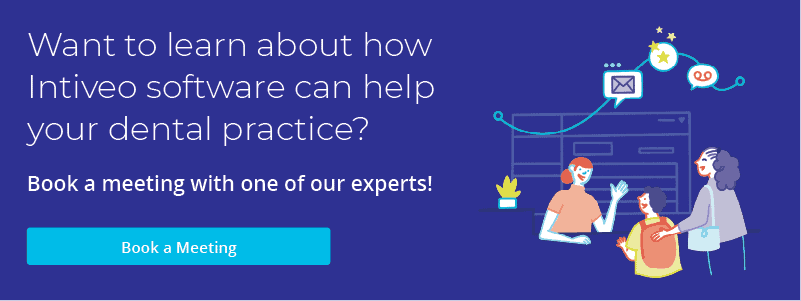Patient Engagement in the Modern Age
Dentistry is a challenging profession for many reasons. As for any medical professional, the stakes are high. Delivering excellent oral health care outcomes is of the utmost importance. But, since dental practices are also small businesses, there is an extra dimension to delivering care. The dental industry is changing rapidly, and with it, patient expectations. This is where patient engagement becomes such an important part of the equation.
Patients now expect their dentists to treat them not just as patients, but also as clients. When patients go to the barber or to the salon, for example, they receive not only appointment reminders. They also receive instructions on where to park, information about how to pay, and so on – all with the immediacy of a text message. Patients expect high levels of communication. They want to know their business has value to your practice.
But, it’s challenging for practices to meet these expectations. The expectations themselves can feel impossible to meet.
In this blog, we will discuss what those challenges are – and how to tackle them so you can deliver on patient engagement.
Identifying the Challenges

Patient engagement results in loyal patients. In some ways, it’s as simple as that. If you meet your patients’ needs, they will choose your practice again and again.
When it comes to patient engagement, the first step is identifying what the challenges are. For many dental practices, it is often one of the following:
- Funds: A lack of funds is a challenge that many dental practices face. Truly, the financial part of running a small business of any type can be challenging. This is especially true in dentistry, where you need to purchase costly equipment that is necessary to run a successful practice. Allocating funds to patient engagement might be at the bottom of your list.
- Time: As we’ll explore in greater detail a little further down, your staff might simply be strapped for time. Following up with patients, attending to patients at the office, and processing important information take up quite a bit of time all on their own. If your current patient engagement strategy involves a lot of telephoning patients, this can be particularly time-consuming.
- Resources: Patient engagement requires resources. Staff time, as we’ve noted, is a big part of that. But it also requires engagement tools. Patient engagement software can help organize and streamline for staff. Plus, it automates many of the perks that a patient now expects. Some examples of this include reminders to fast for an extraction or to take medication before a significant dental procedure – or even just an appointment reminder! Having a working strategy in place can also be a great resource. This allows your staff to follow a program that the practice has set out and agreed upon.
Once you have identified the challenges, you can evolve a strategy and utilize resources to prioritize your patients.
But how exactly is that done?
Building Your Strategy & Finding the Right Software
It’s one thing to say that technology and strategy will drive patient engagement. It’s another to implement them.
Many practices don’t know where to start to select a good patient engagement software. When you aren’t prioritizing patient engagement, it can be hard to make a selection based on your needs. The market has many different types of software to offer. You may not quite know what your patient’s needs are, yet! Strategy, too, can be hard to organize when you’re not sure what your patients’ needs are.
To build your strategy, here are some things to consider:
- The different kinds of procedures that your practice offers. For example, do your patients need reminding to come prepared for appointments? Do they need to fast? To take medication beforehand? Follow-ups about aftercare?
- The age demographic of your patients. Do they want to be contacted by phone? By text? Older patients will often prefer a phone call, but younger patients prefer to text and email.
- What your staff has capacity for. Do they have the time to make multiple phone calls? Would automating messaging to patients make it any easier?
Once you have built your strategy, you can make a selection about what kind of software will work for you for patient engagement. Choose software that will allow you to carry out the strategy as efficiently as possible.
For example, let’s say you are an OMS practice; the surgeons do a number of procedures that require fasting, medication, and aftercare. So, you need to select software that will allow you to complete those complex messaging cadences to ensure a successful outcome for each appointment.
Luckily, there is guidance around what kind of software to buy. Capterra, as well as G2, allows you to compare and contrast different brands of software, including dental software.
Making the Shift Toward Patient Engagement

Perhaps one of the most frustrating challenges of patient engagement is when you choose software that will make their experience better – and then the patients are resistant to change!
Onboarding patients to a new system can be a long process. Many patients have trouble adjusting to new methods of communication. When you choose a software that allows patients to choose their communication method, a lot of this resistance can be avoided. This way, patients who prefer to be contacted by phone, for example, can keep that preference.
Always remember two things. One: with the right support, making this shift truly pays off. Two: it doesn’t have to be a long process, with the right prep. One of the best ways to get your patients on board is to give them plenty of advance warning. This can be the first stepping stone in an improved patient engagement relationship. Post about the change in your office, send emails and offer a handout detailing the change. In particular, highlight how the change will improve their experience with your practice!
Another challenge can be that your staff is resistant to the change. While everyone might understand that patient engagement is important, staff may disagree on what the best methods are to do that. Or, they might feel intimidated by having to learn new software or skills.
Of course, learning a whole new strategy and the ins and outs of a new software can be a lot to manage! In supporting your staff with this change, make sure the strategy is agreed upon. If the logic for the strategy is evident, the change will be less stressful.
Selecting software whose company offers a great customer-facing team and onboarding process is paramount! Find the right team to support your team.
Intiveo: Bringing You Closer to Your Patients
To give an example of what that can look like, let’s look at Intiveo. Intiveo’s software can be specialized for different types of dental practices, from OMS to general practices. This means you can further specialize to allow for different types of messaging cadences, depending on the procedure.
But, like with any software, what allows your practice to excel is automation. Our software allows you to program automatic messaging to patients based on their needs. In supporting your staff to learn to use our software, our customer-facing team onboards and trains them over the course of a month. From there, your team always has access to a support team should any further issues arise.
Curious to learn more about what Intiveo can do for you? Book a meeting!
Your Practice & Patient Engagement
Overcoming the challenges of patient engagement can be hard. Meeting the expectations of the modern patient requires resources and commitment. We know you want to deliver great oral health outcomes – while showing your patients you value them.
But, with the right kind of support, success is absolutely possible! Building the strategy that your practice needs is the first step. Then, you work on finding the right tools to support this strategy. Often, this will take the form of patient engagement software. Take into consideration what your practice offers as services. Take into consideration what your staff has capacity for, and how your patients like to communicate.
Making the shift to prioritizing patient engagement can truly pay off. By preparing your patients for a switch to different – and better! – communication, you bring them along as partners in their oral health.
The future looks good when you engage with your patients!






